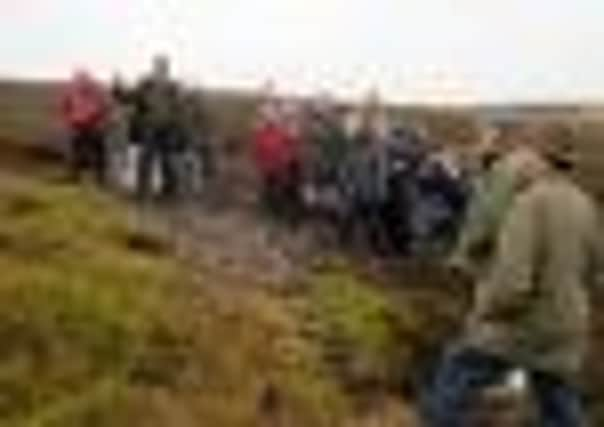Opening eyes to moorland realities


But over much of the north and east sides of the Dales’ uplands, heather moorland is the predominant habitat, and all of it is managed for grouse shooting.
It’s fair to say that most members of the Yorkshire Dales Society – an independent organisation which works to protect, conserve and promote the national park – are walkers rather than part of the grouse-shooting fraternity. Some of them may even harbour concerns that such vast acreages of the Dales are run for the sport of a wealthy elite.
Advertisement
Hide AdAdvertisement
Hide AdSo in the quest for a deeper understanding, plus the prospect of a good leg-stretcher across some of the outlying Broad Acres, about 20 members of the YDS met in Arkengarthdale at the invitation of the local moorland estate to find out why grouse moors exist, how they are run, and what benefits they bring – not just for the wildlife and the landscape but also for ramblers and lovers of the Yorkshire Dales.
They were greeted by wet and windy weather. “Actually, all that dry weather early in the spring worries me,” explained Dr Phil Warren, the scientist running the Game and Wildlife Conservation Trust’s North Pennines Black Grouse Recovery Project. “If we get an early dry spell it could mean that we’ll get rain later in the spring. If it rains in June like it did in 2007 and 2008 then the black grouse will breed poorly.”
Black grouse – larger, more flamboyant relatives of the sportsman’s red grouse – were once widespread across the Dales. They’re now confined to moorland fringes north of Wensleydale and Arkengarthdale now holds 30 per cent.
The black grouse is one of several birds which benefit from their association with grouse moorland, according to Adrian Blackmore, moorlands director of the Countryside Alliance, who was here to talk about the wider aspects of managing heather moors and explain that where a good management regime was in place, black grouse prospered.
Advertisement
Hide AdAdvertisement
Hide AdSo too did grey partridge, another bird which has seen a crash in numbers throughout England. And perhaps the biggest beneficiary of grouse moor conservation were wading birds like lapwing, curlew, redshank and golden plover, which spend the winters on the coast but each spring arrive in the uplands to breed.
Adrian said a 10-year research project by the Game and Wildlife Conservation Trust at Otterburn on the impact of legal predator control on the breeding success of ground-nesting birds like waders found that those birds on moors where predator control took place were three times more likely to breed successfully than those waders nesting where predators were not controlled.
What control means in practice is something many walkers and birdwatchers rarely get the chance to see. But the methods employed were on display for the YDS. They ranged from larsen traps – cages used for catching carrion crows, rooks, jackdaws and magpies – to simple fenn traps for snaring the most destructive predators – stoats and weasels.
Are birds like the peregrine and goshawk harmful predators on grouse moorland? Dr Warren said peregrines were known to kill red and black grouse in winter, but in small numbers “that were not of much consequence to the general population”.
Advertisement
Hide AdAdvertisement
Hide AdCarrion crows, which eat the eggs and young of all ground-nesting birds, were now rarely seen on Arkengarthdale’s uplands thanks to gamekeepers. But predators like rats, stoats and weasels would never be wiped out.
“We’re talking about control of them,” Adrian Blackmore said. “It’s important to emphasise that we’re not talking about total eradication, merely keeping a balance which allows ground nesters to survive.”
Headkeeper of the East Arkengarthdale Estate, Richard Coates, demonstrated the equipment used for maintaining moorland, contrasting the old labour-intensive methods used for burning blocks of heather to promote new growth using a paraffin torch and pole “floggers” for beating out the flames with an eight-wheeled Argocat, a sort of moorland fire engine.
“Now we can burn up to 100 fires a day,” he said. “With the old floggers we’d be doing up to a dozen and get tired. The benefit of the equipment is that we can do what we call ‘cooler’ burns. We’re not damaging the surface sphagnum mosses or the top layer of peat.”
Advertisement
Hide AdAdvertisement
Hide AdAdrian Blackmore pointed out a drainage channel, or “grip” which was dug in the 1970s to make the uplands better for livestock grazing. These grips are now being blocked up, since they hasten rainfall run-off and make flooding more likely in places like York.
The expenditure by moorland owners last year was more than £50m, he said. “Most grouse moor owners don’t aim to make a profit, because that’s unrealistic. Many of them are extremely successful businessmen, but sometimes one must wonder about their judgment as to why on earth they take on a grouse moor.”
The YDS chairman, Colin Speakman, was convinced by what he saw. The bird life of grouse moorland depended on the way it was managed, he said, and that was underpinned economically by shooting.
“To be honest,” he added, “the moorlands are managed for us lot too...for walkers.” He nodded to his fellow YDS members. “We come out and enjoy this landscape. If these moors are being kept in prime condition for the rest of us so that a bunch of businessmen from Japan can come over here to shoot a few grouse, I think I’m happy with that.”